Performance Enhancement of Electrospun IGZO-Nanofiber-Based Field-Effect Transistors with High-k Gate Dielectrics through Microwave Annealing and Postcalcination Oxygen Plasma Treatment
Abstract
1. Introduction
2. Materials and Methods
2.1. Synthesis of IGZO/PVP Precursor Solution
2.2. Fabrication of IGZO NF FETs
2.3. Characterization Methods
3. Results and Discussion
3.1. Structural and Optical Properties of IGZO NFs
3.2. Electrical Properties of IGZO NF FETs
3.3. Stability of IGZO NF FETs
3.4. Chemical Properties of Electrospun IGZO NFs
4. Conclusions
Author Contributions
Funding
Conflicts of Interest
References
- Wang, X.; Zhang, Y.; Zhang, X.; Huo, Z.; Li, X.; Que, M.; Pan, C. A highly stretchable transparent self-powered triboelectric tactile sensor with metallized nanofibers for wearable electronics. Adv. Mater. 2018, 30, 1706738. [Google Scholar] [CrossRef]
- Xue, J.; Xie, J.; Liu, W.; Xia, Y. Electrospun nanofibers: New concepts, materials, and applications. Acc. Chem. Res. 2017, 50, 1976–1987. [Google Scholar] [CrossRef] [PubMed]
- Hong, S.; Lee, H.; Lee, J.; Kwon, J.; Han, S.; Suh, Y.D.; Ko, S.H. Highly stretchable and transparent metal nanowire heater for wearable electronics applications. Adv. Mater. 2015, 27, 4744–4751. [Google Scholar] [CrossRef] [PubMed]
- Jin, R.; Zeng, C.; Zhou, M.; Chen, Y. Atomically precise colloidal metal nanoclusters and nanoparticles: Fundamentals and opportunities. Chem. Rev. 2016, 116, 10346–10413. [Google Scholar] [CrossRef]
- Pawbake, A.S.; Island, J.O.; Flores, E.; Ares, J.R.; Sanchez, C.; Ferrer, I.J.; Late, D.J. Temperature-dependent Raman spectroscopy of titanium trisulfide (TiS3) nanoribbons and nanosheets. ACS Appl. Mater. Interfaces 2015, 7, 24185–24190. [Google Scholar] [CrossRef] [PubMed]
- Choi, S.; Lee, H.; Ghaffari, R.; Hyeon, T.; Kim, D.H. Recent advances in flexible and stretchable bio-electronic devices integrated with nanomaterials. Adv. Mater. 2016, 28, 4203–4218. [Google Scholar] [CrossRef] [PubMed]
- Yao, S.; Zhu, Y. Nanomaterial-enabled stretchable conductors: Strategies, materials and devices. Adv. Mater. 2015, 27, 1480–1511. [Google Scholar] [CrossRef] [PubMed]
- Liu, A.; Meng, Y.; Zhu, H.; Noh, Y.Y.; Liu, G.; Shan, F. Electrospun p-type nickel oxide semiconducting nanowires for low-voltage field-effect transistors. ACS Appl. Mater. Interfaces 2017, 10, 25841–25849. [Google Scholar] [CrossRef] [PubMed]
- Thenmozhi, S.; Dharmaraj, N.; Kadirvelu, K.; Kim, H.Y. Electrospun nanofibers: New generation materials for advanced applications. Mater. Sci. Eng. B 2017, 217, 36–48. [Google Scholar] [CrossRef]
- Zhang, B.; Kang, F.; Tarascon, J.M.; Kim, J.K. Recent advances in electrospun carbon nanofibers and their application in electrochemical energy storage. Prog. Mater. Sci. 2016, 76, 319–380. [Google Scholar] [CrossRef]
- Olson, D.C.; Piris, J.; Collins, R.T.; Shaheen, S.E.; Ginley, D.S. Hybrid photovoltaic devices of polymer and ZnO nanofiber composites. Thin Solid Films 2006, 496, 26–29. [Google Scholar] [CrossRef]
- Wang, D.; Zhang, M.; Chen, Z.; Li, H.; Chen, A.; Wang, X.; Yang, J. Enhanced formaldehyde sensing properties of hollow SnO2 nanofibers by graphene oxide. Sens. Actuators B Chem. 2017, 250, 533–542. [Google Scholar] [CrossRef]
- Lin, K.; Chua, K.N.; Christopherson, G.T.; Lim, S.; Mao, H.Q. Reducing electrospun nanofiber diameter and variability using cationic amphiphiles. Polymer 2007, 48, 6384–6394. [Google Scholar] [CrossRef]
- Di Mauro, A.; Zimbone, M.; Fragalà, M.E.; Impellizzeri, G. Synthesis of ZnO nanofibers by the electrospinning process. Mater. Sci. Semicond. Process. 2016, 42, 98–101. [Google Scholar] [CrossRef]
- Xu, F.; Le, Y.; Cheng, B.; Jiang, C. Effect of calcination temperature on formaldehyde oxidation performance of Pt/TiO2 nanofiber composite at room temperature. Appl. Surf. Sci. 2017, 426, 333–341. [Google Scholar] [CrossRef]
- Zhang, Q.X.; Ge, Y.P.; Gu, X.Q.; Peng, F.; Luo, M. The effects of rapid thermal annealing and microwave annealing on the electrical properties of ZrO2 metal-insulator-metal capacitors. Optik 2019, 179, 1057–1062. [Google Scholar] [CrossRef]
- Yang, H.; Li, C.; Yue, L.; Wen, C.; Zhang, J.; Wu, D. Improving electrical performance of few-layer MoS2 FETs via microwave annealing. IEEE Electron. Device Lett. 2019, 40, 1116–1119. [Google Scholar] [CrossRef]
- Martins, A.; Pinho, E.D.; Faria, S.; Pashkuleva, I.; Marques, A.P.; Reis, R.L.; Neves, N.M. Surface modification of electrospun polycaprolactone nanofiber meshes by plasma treatment to enhance biological performance. Small 2009, 5, 1195–1206. [Google Scholar] [CrossRef]
- Ke, J.C.; Wang, Y.H.; Chen, K.L.; Huang, C.J. Effect of organic solar cells using various power O2 plasma treatments on the indium tin oxide substrate. J. Colloid Interface Sci. 2016, 465, 311–315. [Google Scholar] [CrossRef] [PubMed]
- Liu, P.; Chen, T.P.; Liu, Z.; Tan, C.S.; Leong, K.C. Effect of O2 plasma immersion on electrical properties and transistor performance of indium gallium zinc oxide thin films. Thin Solid Films 2013, 545, 533–536. [Google Scholar] [CrossRef]
- Wang, Y.; Chen, Y.T.; Xue, F.; Zhou, F.; Lee, J.C. Effects of SF6 plasma treatment on electrical characteristics of TaN-Al2O3-InP metal-oxide-semiconductor field-effect transistor. Appl. Phys. Lett. 2012, 101, 063505. [Google Scholar] [CrossRef]
- Yang, S.; Hwan Ji, K.; Ki Kim, U.; Seong Hwang, C.; Ko Park, S.H.; Hwang, C.S.; Kyeong Jeong, J. Suppression in the negative bias illumination instability of Zn-Sn-O transistor using oxygen plasma treatment. Appl. Phys. Lett. 2011, 99, 102103. [Google Scholar] [CrossRef]
- Nayak, P.K.; Hedhili, M.N.; Cha, D.; Alshareef, H.N. High performance solution-deposited amorphous indium gallium zinc oxide thin film transistors by oxygen plasma treatment. Appl. Phys. Lett. 2012, 100, 202106. [Google Scholar] [CrossRef]
- Fuh, C.S.; Liu, P.T.; Teng, L.F.; Huang, S.W.; Lee, Y.J.; Shieh, H.P.D.; Sze, S.M. Effects of microwave annealing on nitrogenated amorphous In-Ga-Zn-O thin-film transistor for low thermal budget process application. IEEE Electron. Device Lett. 2013, 34, 1157–1159. [Google Scholar] [CrossRef]
- Kamiya, T.; Nomura, K.; Hosono, H. Present status of amorphous In–Ga–Zn–O thin-film transistors. Sci. Technol. Adv. Mat. 2010, 11, 044305. [Google Scholar] [CrossRef]
- Coropceanu, V.; Cornil, J.; da Silva Filho, D.A.; Olivier, Y.; Silbey, R.; Brédas, J.L. Charge transport in organic semiconductors. Chem. Rev. 2007, 107, 926–952. [Google Scholar] [CrossRef]
- Ang, Y.S.; Zubair, M.; Ang, L.K. Relativistic space-charge-limited current for massive Dirac fermions. Phys. Rev. B Condens. Matter. 2017, 95, 165409. [Google Scholar] [CrossRef]
- Lampert, M.A. Simplified theory of space-charge-limited currents in an insulator with traps. Phys. Rev. B Condens. Matter. 1956, 103, 1648. [Google Scholar] [CrossRef]
- Fuh, C.S.; Liu, P.T.; Huang, W.H.; Sze, S.M. Effect of annealing on defect elimination for high mobility amorphous indium-zinc-tin-oxide thin-film transistor. IEEE Electron. Device Lett. 2014, 35, 1103–1105. [Google Scholar] [CrossRef]
- Jeong, J.K.; Won Yang, H.; Jeong, J.H.; Mo, Y.G.; Kim, H.D. Origin of threshold voltage instability in indium-gallium-zinc oxide thin film transistors. Appl. Phys. Lett. 2008, 93, 123508. [Google Scholar] [CrossRef]
- Noh, H.K.; Chang, K.J.; Ryu, B.; Lee, W.J. Electronic structure of oxygen-vacancy defects in amorphous In-Ga-Zn-O semiconductors. Phys. Rev. B 2011, 84, 115205. [Google Scholar] [CrossRef]
- Cho, M.; Aoulaiche, M.; Degraeve, R.; Kaczer, B.; Franco, J.; Kauerauf, T.; Groeseneken, G. Positive and negative bias temperature instability on sub-nanometer EOT high-K MOSFETs. In Proceedings of the 2010 IEEE International Reliability Physics Symposium, Anaheim, CA, USA, 2–6 May 2010; pp. 1095–1098. [Google Scholar]
- Chen, W.T.; Lo, S.Y.; Kao, S.C.; Zan, H.W.; Tsai, C.C.; Lin, J.H.; Lee, C.C. Oxygen-dependent instability and annealing/passivation effects in amorphous In–Ga–Zn–O thin-film transistors. IEEE Electron. Device Lett. 2011, 32, 1552–1554. [Google Scholar] [CrossRef]
- Chen, Y.C.; Chang, T.C.; Li, H.W.; Chen, S.C.; Lu, J.; Chung, W.F.; Tseng, T.Y. Bias-induced oxygen adsorption in zinc tin oxide thin film transistors under dynamic stress. Appl. Phys. Lett. 2010, 96, 262104. [Google Scholar] [CrossRef]
- Suresh, A.; Muth, J.F. Bias stress stability of indium gallium zinc oxide channel based transparent thin film transistors. Appl. Phys. Lett. 2008, 92, 033502. [Google Scholar] [CrossRef]
- Nomura, K.; Kamiya, T.; Hirano, M.; Hosono, H. Origins of threshold voltage shifts in room-temperature deposited and annealed a-In–Ga–Zn–O thin-film transistors. Appl. Phys. Lett. 2009, 95, 013502. [Google Scholar] [CrossRef]
- Jeon, J.H.; Cho, W.J. Multi-and single-step in situ microwave annealing as low-thermal-budget techniques for solution-processed indium–gallium–zinc oxide thin films. Semicond. Sci. Technol. 2018, 34, 015006. [Google Scholar] [CrossRef]
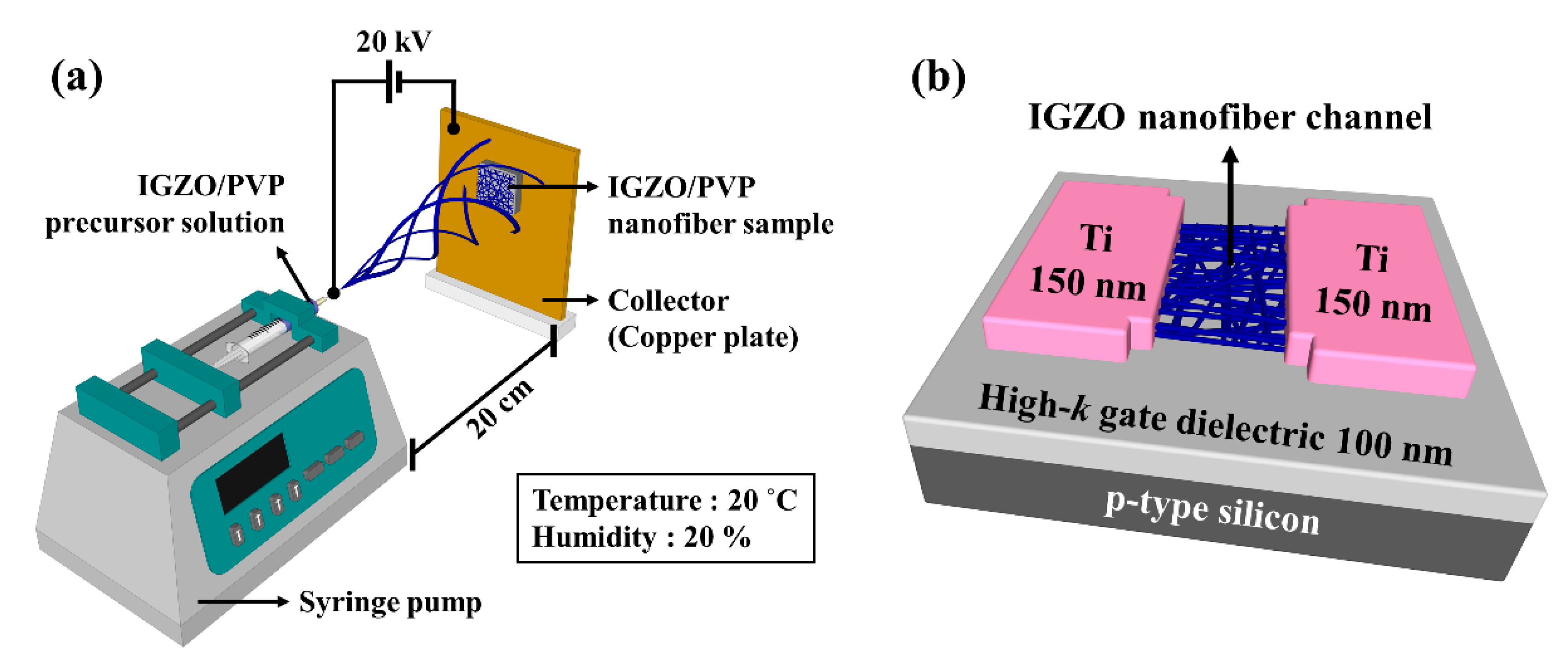


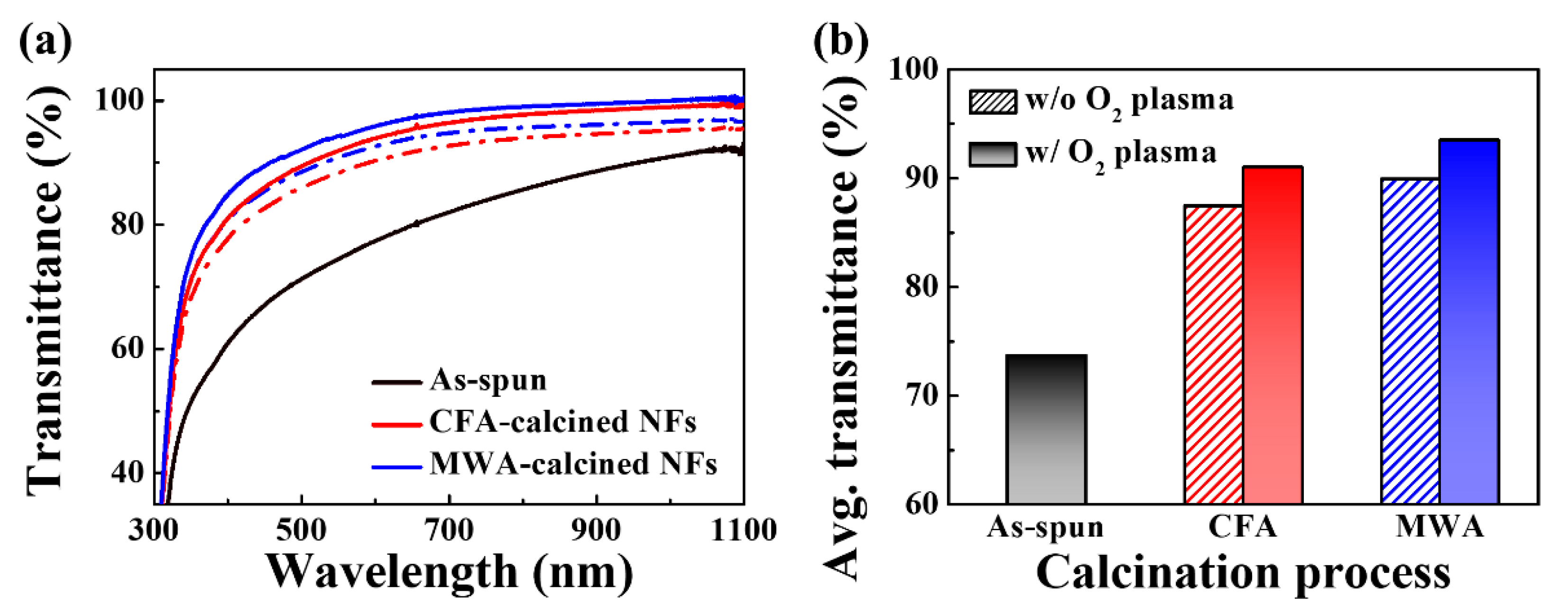
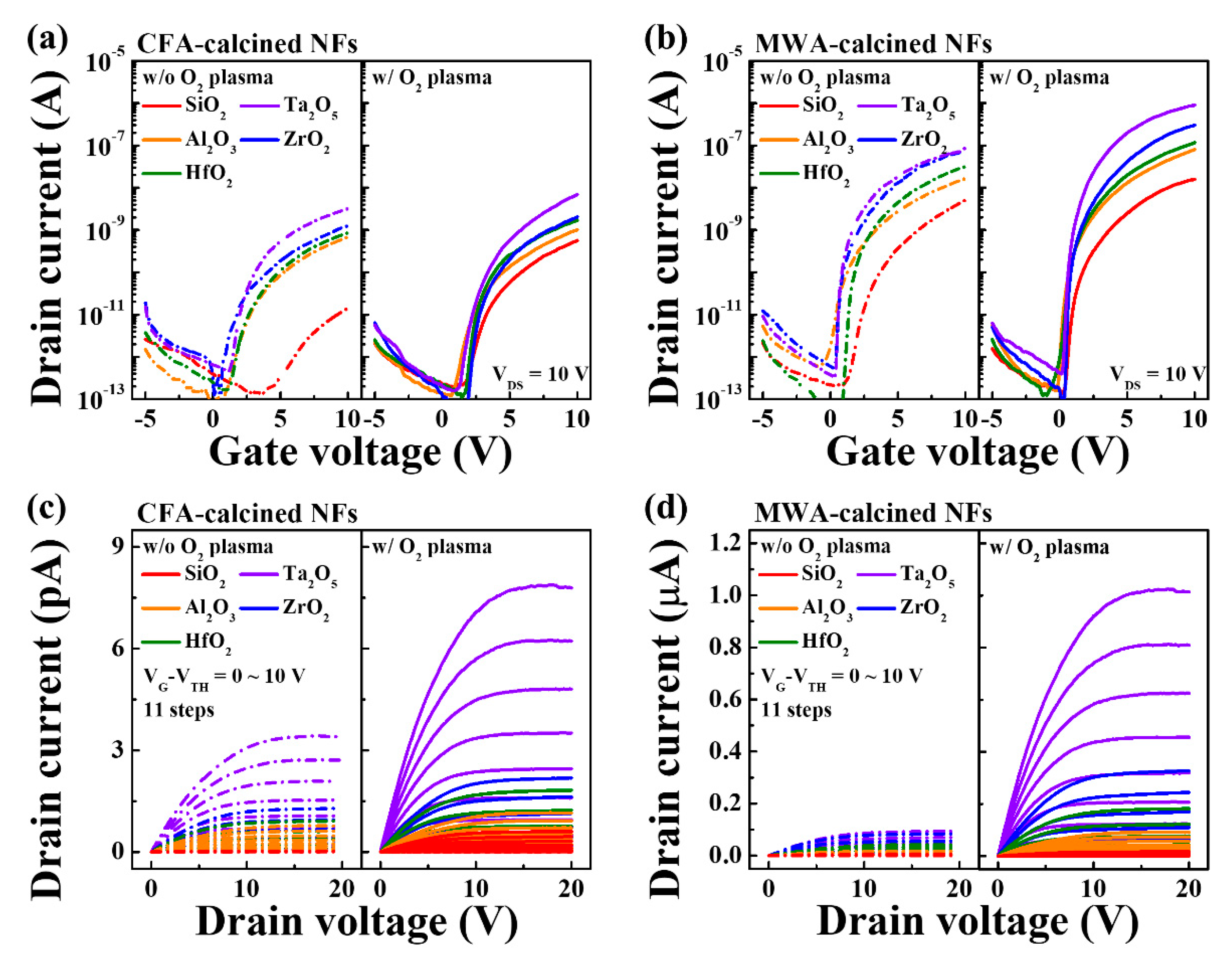
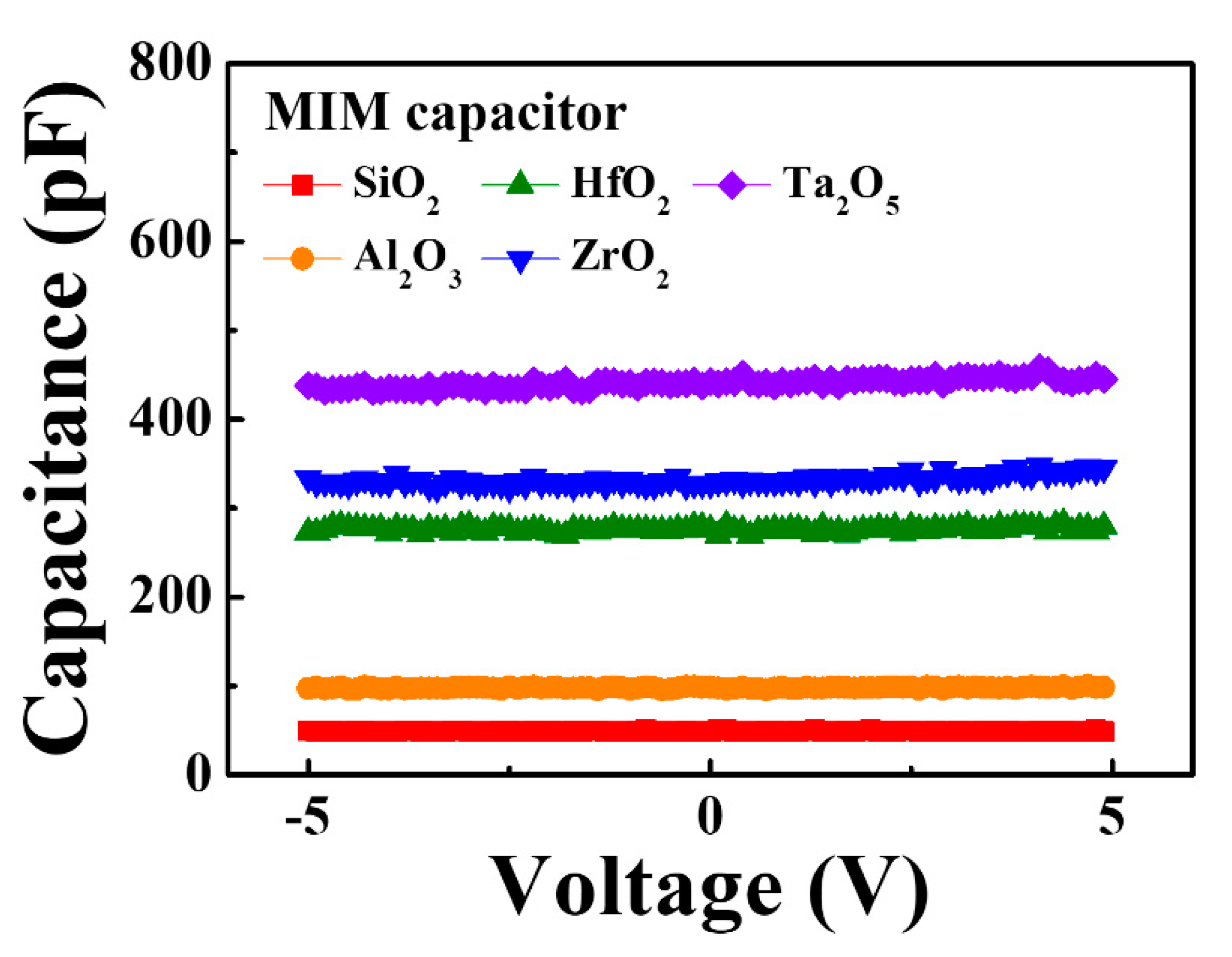
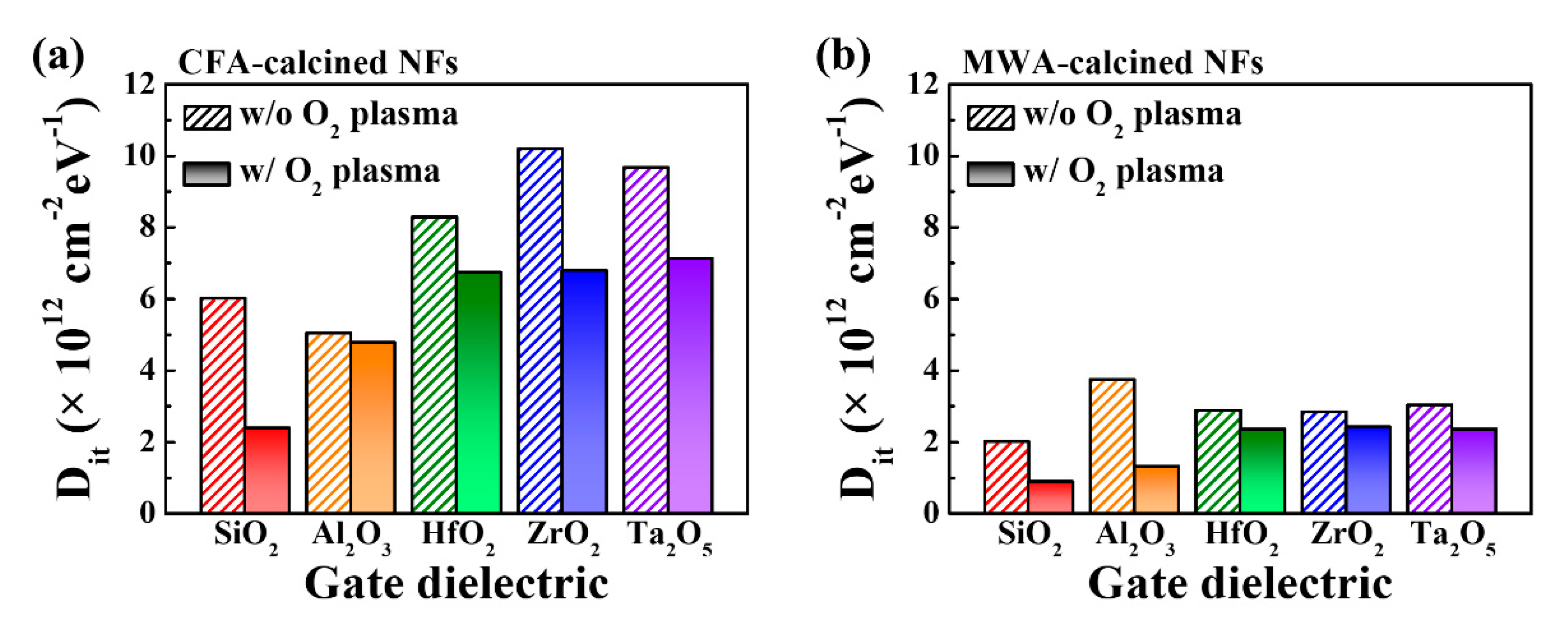
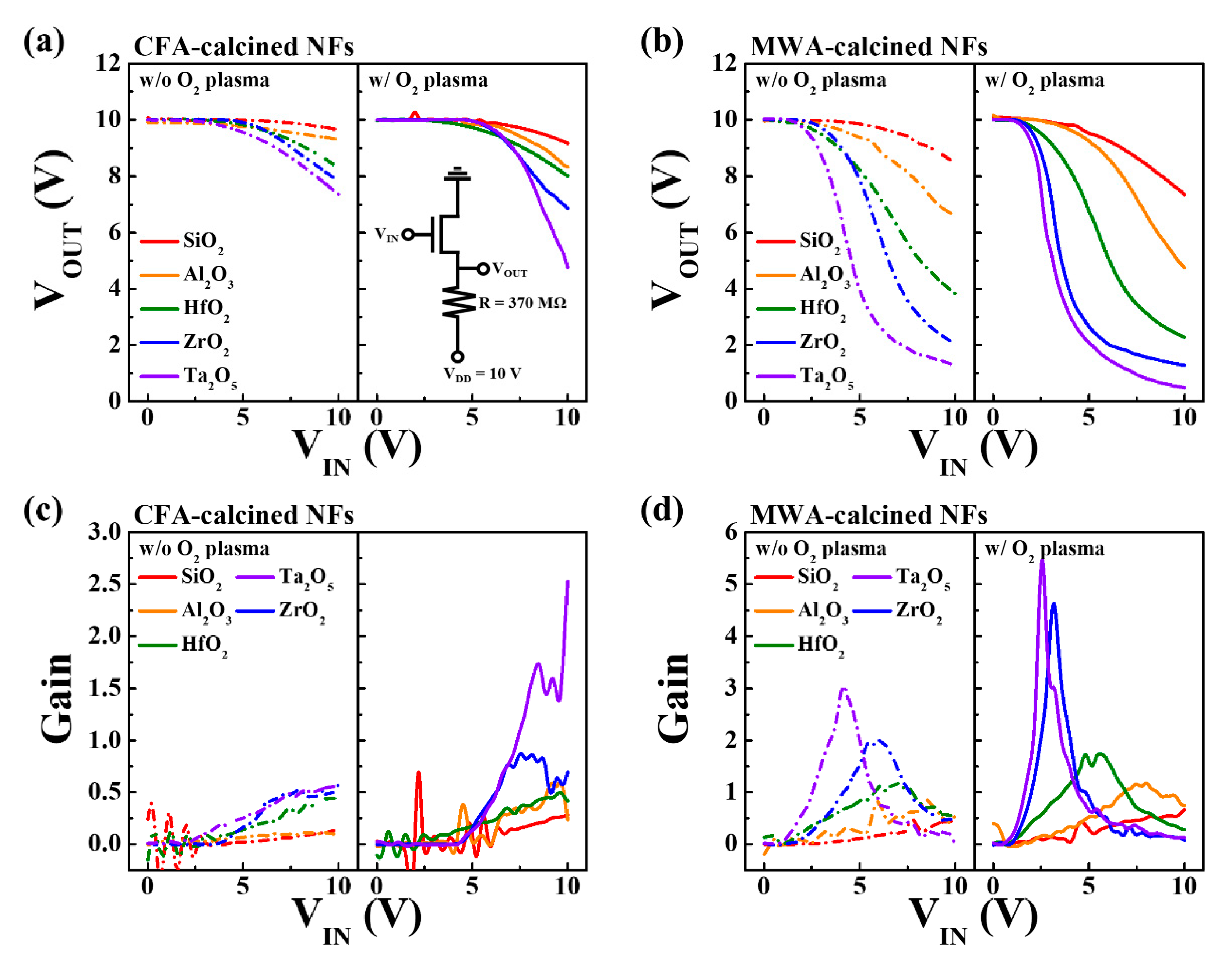
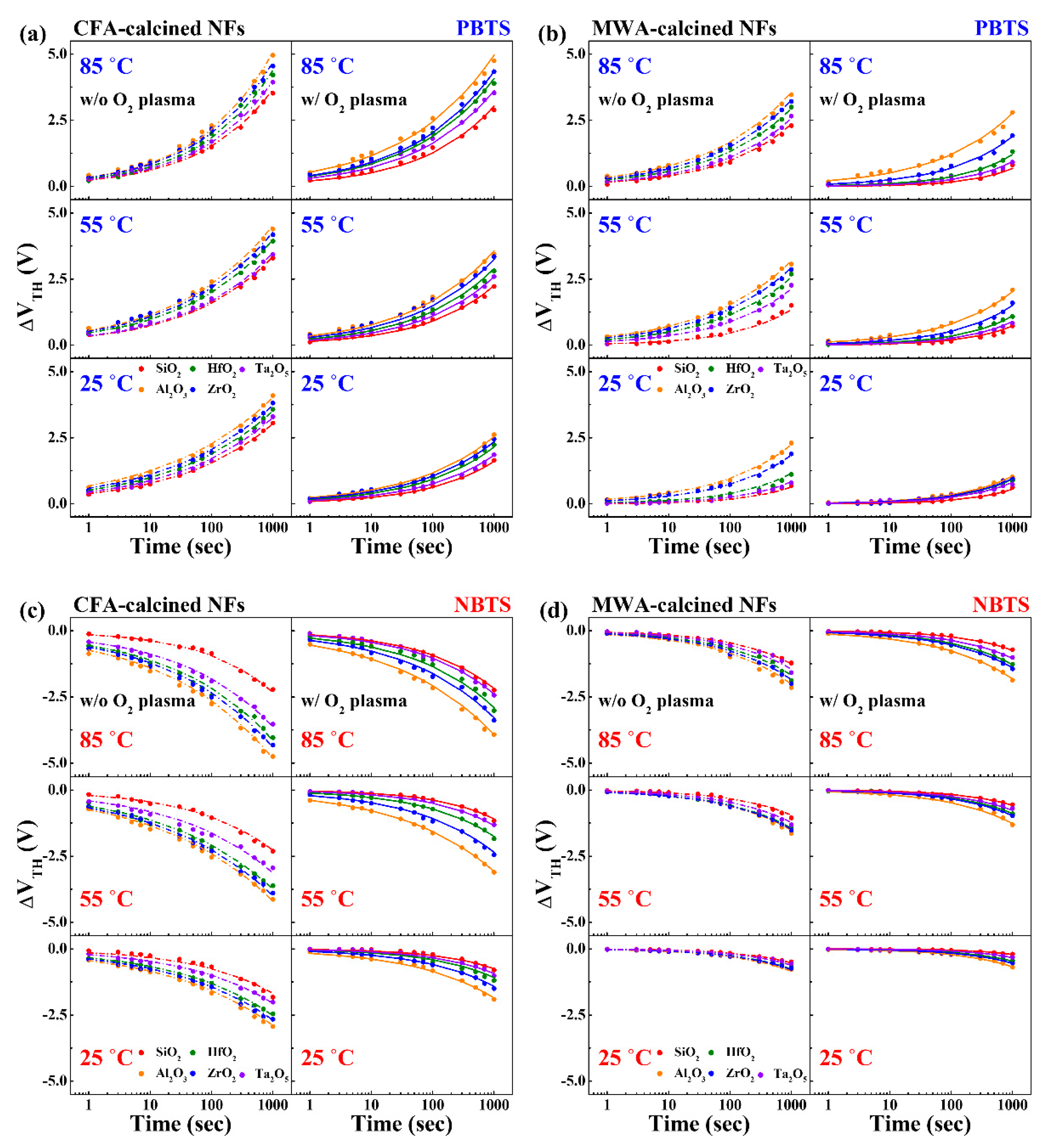
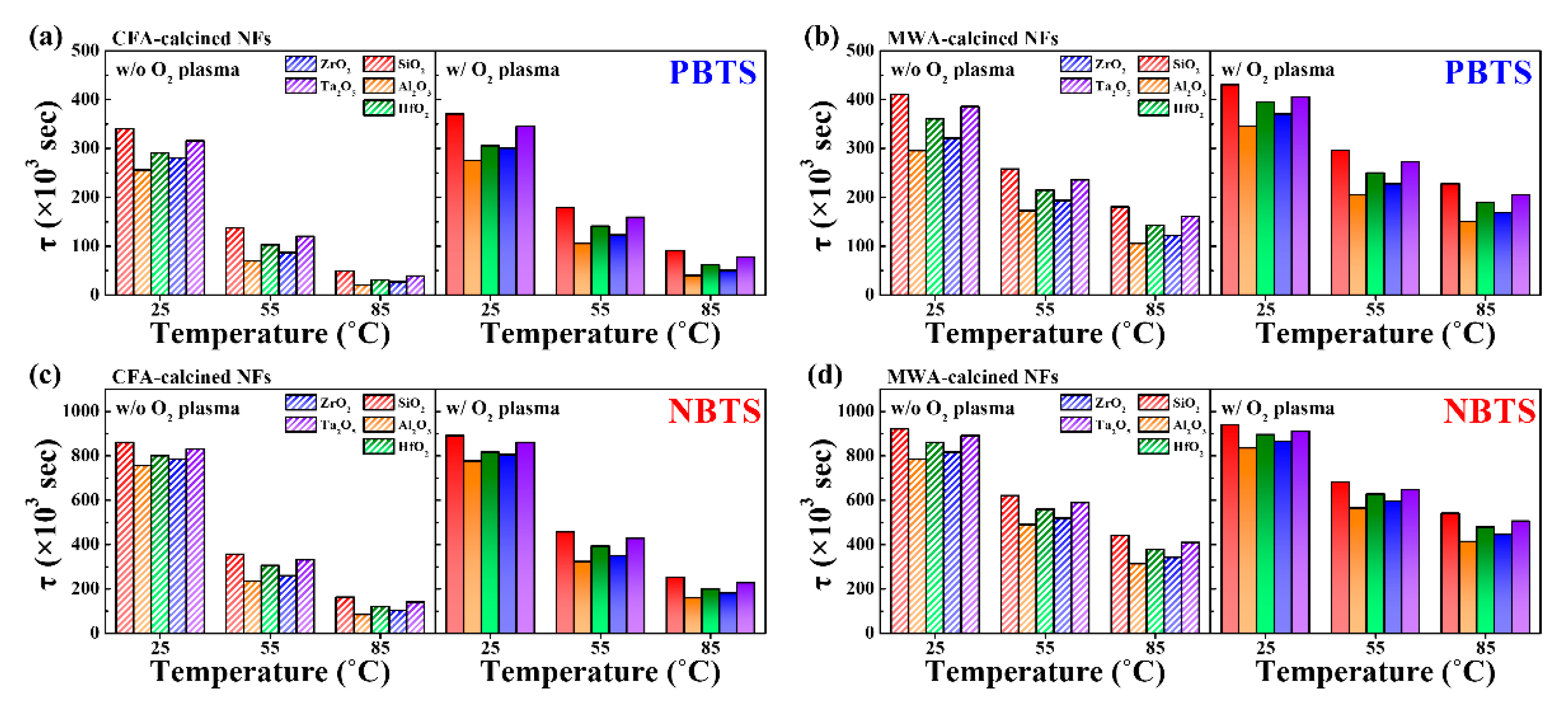
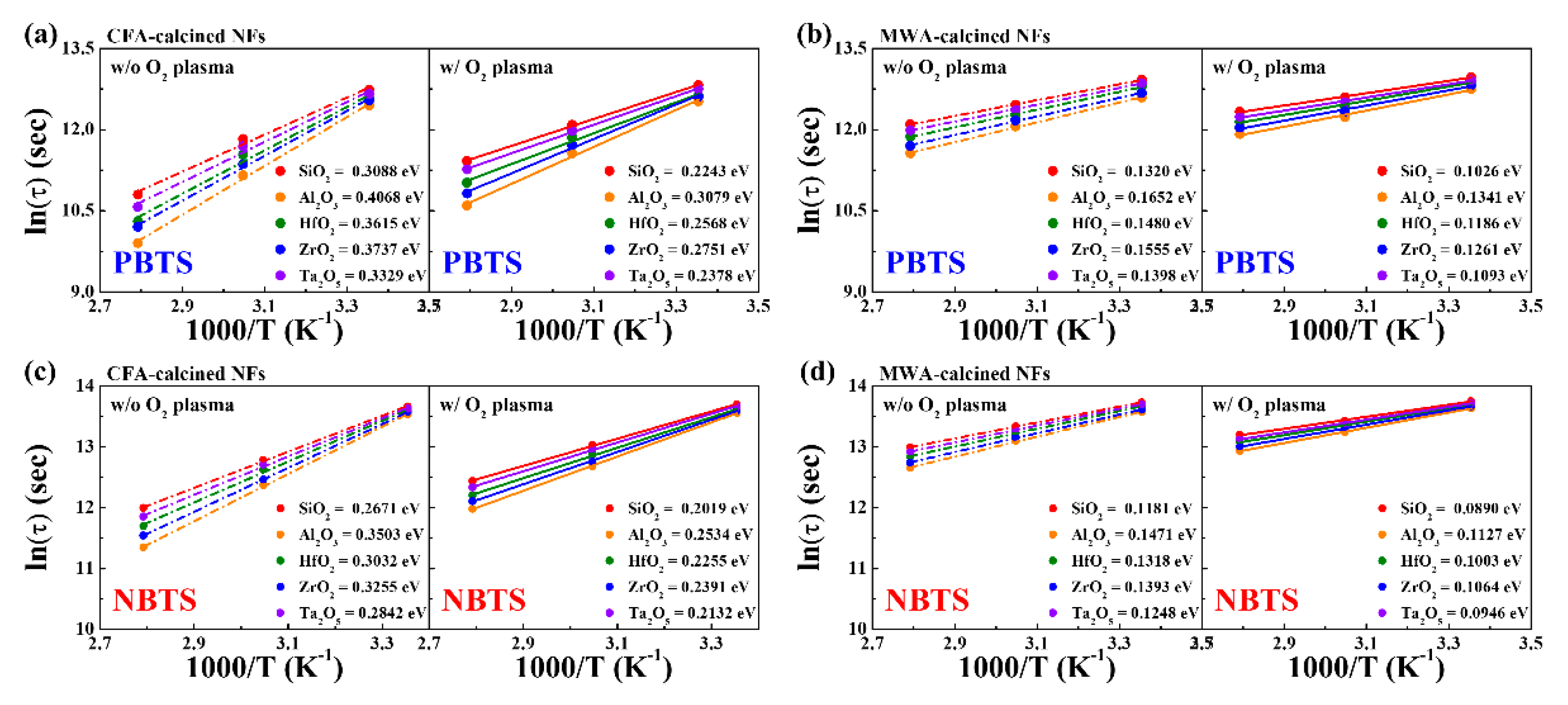
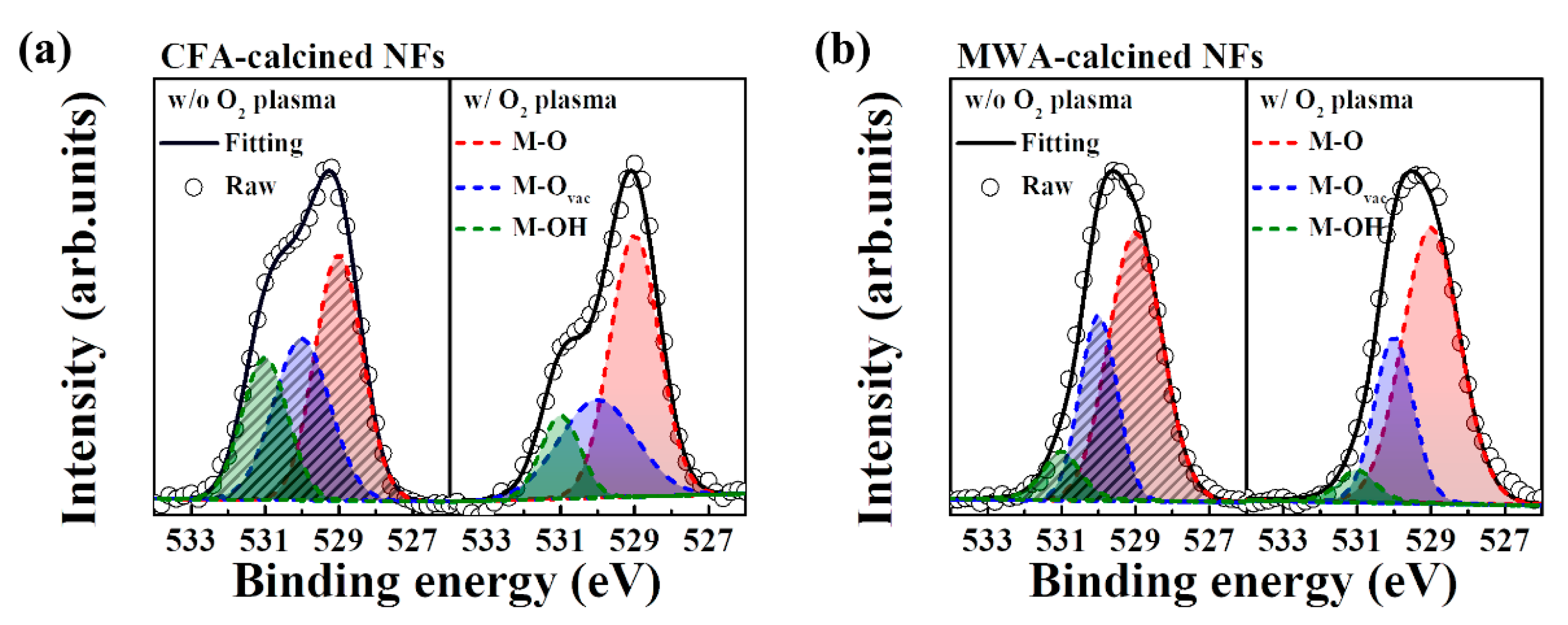
| Method for Calcinating NFs | Gate Dielectric | w/o O2 Plasma Treatment | w/ O2 Plasma Treatment | ||||||
|---|---|---|---|---|---|---|---|---|---|
| VTH (V) | SS (mV/dec) | μFE (cm2/V·s) | ION/IOFF | VTH (V) | SS (mV/dec) | μFE (cm2/V·s) | ION/IOFF | ||
| CTA | SiO2 | 8.6 | 1703.8 | 1.27 × 10−4 | 0.07 × 103 | 3.1 | 676.1 | 1.69 × 10−3 | 2.82 × 103 |
| Al2O3 | 2.6 | 610.7 | 8.25 × 10−4 | 3.42 × 103 | 2.2 | 576.1 | 2.49 × 10−3 | 5.12 × 103 | |
| HfO2 | 2.4 | 504.6 | 1.28 × 10−3 | 4.31 × 103 | 2.4 | 409.4 | 4.02 × 10−3 | 8.42 × 103 | |
| ZrO2 | 1.6 | 491.3 | 2.07 × 10−3 | 5.10 × 103 | 2.7 | 327.8 | 4.47 × 10−3 | 1.02 × 104 | |
| Ta2O5 | 1.9 | 387.4 | 2.21 × 10−3 | 1.59 × 104 | 2.1 | 284.9 | 6.38 × 10−3 | 3.46 × 104 | |
| MWA | SiO2 | 2.2 | 568.4 | 2.48 × 10−2 | 0.25 × 104 | 0.9 | 250.6 | 9.92 × 10−2 | 7.93 × 104 |
| Al2O3 | 0.4 | 453.1 | 4.26 × 10−2 | 8.20 × 104 | 0.2 | 160.1 | 1.34 × 10−1 | 4.01 × 105 | |
| HfO2 | 1.3 | 162.9 | 6.54 × 10−2 | 1.58 × 105 | 0.3 | 155.7 | 2.06 × 10−1 | 5.82 × 105 | |
| ZrO2 | 0.6 | 127.3 | 1.09 × 10−1 | 3.83 × 105 | 0.6 | 125.7 | 4.96 × 10−1 | 1.51 × 106 | |
| Ta2O5 | 0.5 | 113.8 | 1.31 × 10−1 | 4.37 × 105 | 0.4 | 102.6 | 6.55 × 10−1 | 4.51 × 106 | |
| w/o O2 Plasma Treatment | w/ O2 Plasma Treatment | |||||
|---|---|---|---|---|---|---|
| M-O (%) | M-Ovac (%) | M-OH (%) | M-O (%) | M-Ovac (%) | M-OH (%) | |
| CFA calcined | 42.8 | 33.3 | 23.9 | 54.5 | 31.7 | 13.8 |
| MWA calcined | 61.6 | 29.1 | 9.3 | 66.4 | 27.4 | 6.2 |
© 2020 by the authors. Licensee MDPI, Basel, Switzerland. This article is an open access article distributed under the terms and conditions of the Creative Commons Attribution (CC BY) license (http://creativecommons.org/licenses/by/4.0/).
Share and Cite
Cho, S.-K.; Cho, W.-J. Performance Enhancement of Electrospun IGZO-Nanofiber-Based Field-Effect Transistors with High-k Gate Dielectrics through Microwave Annealing and Postcalcination Oxygen Plasma Treatment. Nanomaterials 2020, 10, 1804. https://doi.org/10.3390/nano10091804
Cho S-K, Cho W-J. Performance Enhancement of Electrospun IGZO-Nanofiber-Based Field-Effect Transistors with High-k Gate Dielectrics through Microwave Annealing and Postcalcination Oxygen Plasma Treatment. Nanomaterials. 2020; 10(9):1804. https://doi.org/10.3390/nano10091804
Chicago/Turabian StyleCho, Seong-Kun, and Won-Ju Cho. 2020. "Performance Enhancement of Electrospun IGZO-Nanofiber-Based Field-Effect Transistors with High-k Gate Dielectrics through Microwave Annealing and Postcalcination Oxygen Plasma Treatment" Nanomaterials 10, no. 9: 1804. https://doi.org/10.3390/nano10091804
APA StyleCho, S.-K., & Cho, W.-J. (2020). Performance Enhancement of Electrospun IGZO-Nanofiber-Based Field-Effect Transistors with High-k Gate Dielectrics through Microwave Annealing and Postcalcination Oxygen Plasma Treatment. Nanomaterials, 10(9), 1804. https://doi.org/10.3390/nano10091804






